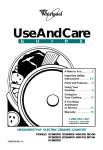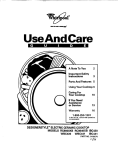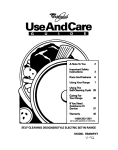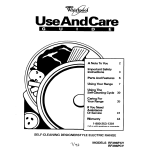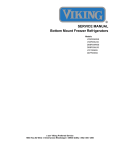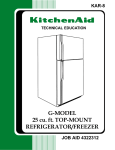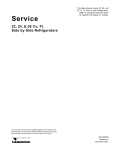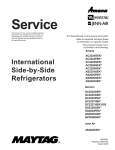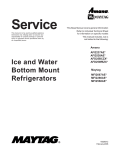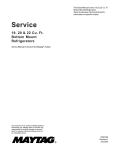Download Whirlpool ED20DFXEB00 Troubleshooting guide
Transcript
CONSUMER SERVICES TECHNICAL EDUCATION GROUP PRESENTS R-84 26" DEEP SIDE - BY SIDE REFRIGERA TOR/ FREEZERS REFRIGERAT MODELS KSBS20QEWH0 KSBS20QEAL0 KSBS20QEBL0 KSFS20QEWH0 KSFS20QEAL0 KSFS20QEBL0 ED20DBXEW00 ED20DBXEN00 ED20DBXEB00 ED20DFXEW00 ED20DFXEN00 ED20DFXEB00 JOB AID Part No. 4321940 i INTRODUCTION This Job Aid, 26" DEEP SIDE-BY-SIDE REFRIGERATOR/FREEZERS, (Part No. 4321940), and the companion video tape, 26" DEEP SIDE-BY-SIDE REFRIGERATOR/FREEZERS, (Part No. 4321970), provides specific information on for the installation, service and repair of 20 cu. ft. side-by-side refrigerator/freezers with 26" deep cabinets. 26" DEEP SIDE-BY-SIDE REFRIGERATOR/FREEZERS has been compiled to provide the most recent information on design, features, troubleshooting, service and repair procedures. Whirlpool required sweep charge procedures are to be strictly adhered to when repairing the sealed system. For a complete explanation of those procedures, refer to the Job Aid, SWEEP CHARGE PROCEDURES FOR THE 90's, (Part No. 4321717) and its companion video (Part No. 4321718.) GOALS AND OBJECTIVES The goal of this Job Aid is to provide detailed information that will enable the service technician to properly diagnose malfunctions and repair 22 cu. ft. side-by-side refrigerator/freezers with 26" deep cabinets. The objectives of the Job Aid are: The service technician will • • • • • Understand proper safety precautions. Follow proper refrigerant recovery procedures. Successfully troubleshoot and diagnose malfunction. Successfully perform necessary repairs. Successfully return the refrigerator/freezer to proper operational status. TO THE INSTRUCTOR/INDEPENDENT STUDENT At the end of certain sections of this Job Aid you will find a "Confirmation of Learning Exercise." A symbol that looks like this ( ✎) indicates that a pencil and two "Hi-Light" markers may be necessary to complete the exercise. Certain exercises may require that service procedures be performed if an appropriate appliance is available. WHIRLPOOL CORPORATION ASSUMES NO RESPONSIBILITY FOR ANY REPAIRS MADE ON OUR PRODUCTS BY ANYONE OTHER THAN AUTHORIZED SERVICE TECHNICIANS. © 1996 Whirlpool Corporation, Benton Harbor, MI 49022 ii TABLE OF CONTENTS INTRODUCTION .................................................................................................................. ii TABLE OF CONTENTS ...................................................................................................... iii SECTION ONE FEATURES AND DESIGN .............................................. 1 Safety .............................................................................................................................. 1 R134a Service Information ............................................................................................. 2 SECTION TWO Installation Considerations ...................................... 3 SECTION THREE THEORY OF OPERATION .............................................. 5 Temperature Controlled Meat Locker .......................................................................................... 5 Ice and Water Dispensers ............................................................................................................ 5 Temperature Control Operation ................................................................................................... 9 Adaptive Defrost Function ......................................................................................................... 10 SECTION FOUR COMPONENT ACCESS ................................................ 13 SECTION FIVE DIAGNOSIS AND TROUBLESHOOTING ................................... 21 Troubleshooting Guide ............................................................................................................... 21 Dignostic Tests ........................................................................................................................... 23 SECTION SIX TECH TIPS ....................................................... 25 Condensation Patterns .............................................................................................................. Wiring Diagram .......................................................................................................................... Strip Circuits ............................................................................................................................... Model Number Designation ....................................................................................................... Product Specification and Warranty Information Sources ......................................................... iii 25 26 27 29 29 iv >> View Section 1 of the Video Tape SECTION 1 GENERAL INFORMATION SAFETY ! WARNING ▲ To avoid the risk of electrical shock, property damage, personal injury or death: • The power cord must be plugged into a 3-prong grounding-type wall receptacle, grounded in accordance with the National Electrical Code, ANSI/NFPA 70 - latest edition and local codes and ordinances. • It is the personal responsibility of the consumer to have a proper 3-prong wall receptacle installed by a qualified electrician. • DO NOT, UNDER ANY CIRCUMSTANCES, REMOVE THE POWER CORD GROUNDING PRONG. • A separate adequately fused and grounded circuit should be available for this appliance. • Do not remove any grounding wires from individual components while servicing, unless the component is to be removed and replaced. It is extremely important to replace all grounding wires when components are replaced. ! ▲ CAUTION To avoid the risk of property damage OR personal injury: • Tape doors closed when adjusting hinges or doors. • do not dispense ice into thin glass, fine china or delicate crystal. Cracks or chips may result from ice dropping into container and from combined pressure of hands and dispenser bar. • When servicing the ice dispenser system, unplug the refrigerator and remove the ice storage bin. 1 R134a REFRIGERANT SERVICE INFORMATION This product uses R134a refrigerant. This refrigerant requires synthetic Ester Oil in the compressor. This cooling system does not tolerate contamination from any of the following: • • • • • • • • Other Refrigerants Moisture Petroleum-based Lubricants Silicone Lubricants Cleaning Compounds Rust Inhibitors Leak Detection Dyes Any Other Type of Additive As a result the following precautions should be observed: • • • • • • Use equipment dedicated to R134a sealed system service only. Do not leave a replacement compressor open to the atmosphere for more than 10 minutes. Always replace the filter-drier when performing any repairs on the sealed system. USE ONLY R134a REFRIGERANT FOR BACKFLUSHING AND SWEEP PROCEDURES. If the rubber plugs on the service replacement compressor appear to have been tampered with or removed, DO NOT USE THE COMPRESSOR. Get another one. The filter-drier MUST be cut from the sealed system. Never unbraze the filter-drier from system tubing. Applying heat will drive moisture back into the sealed system. HEALTH AND SAFETY HANDLING Allowable Overall Exposure Limit Vapor Exposure to Skin Liquid Exposure to Skin Vapor Exposure to Eyes Liquid Exposure to Eyes Above Minimum Exposure Limit Safety and Handling Spill Management Fire and Explosion Hazards Storage Conditions Disposal Procedure R134a 1,000 ppm No Effect Can Cause Frostbite Very Slight Irritation Can Cause Frostbite Can Cause Asphyxiation, Tachycardia and Cardiac Arrhythmias. Wear appropriate Skin and Eye protection. Use adequate Ventilation. Remove or Extinguish Ignition or Combustible Sources. Evacuate or Ventilate Area. May Decompose if contact with Flames and Heating elements. Container May Explode IF Heated Due to Pressure Rise. Combustion Products are Toxic. The Procedures/Rules for R12 also Apply to R134a. Reclaim SEE SWEEP CHARGE PROCEDURES FOR THE 90's, Part No. 4321717 FOR COMPLETE INSTRUCTION ON SERVICING THE SEALED SYSTEM. 2 >> View Section 2 of the Video Tape SECTION 2 GENERAL INFORMATION INSTALLATION CONSIDERATIONS LEVELING THE UNIT AND ALIGNING THE DOORS ▲ ▲ Top Hinge Locations ▲ Rear Roller Adjustment Screw Fig. 1 ▲ Toe Grille Location Front Roller Adjustment Screw ▲ Door Too Low ▲ ▲ ▲ ▲ ▲ ▲ Door Too Low Fig. 3 Fig. 2 Shim Shim Hinge Cover Door Closer Fig. 4 Top Hinge Bottom Hinge Shim 3 Shim Shim ALIGNMENT AND LEVELING PROCEDURES FLOW CHART Slide Unit into Final Location. ▲ Is Unit Stable? NO ▲ YES 1. Remove toe grille by pulling forward at each end. 2. Turn roller adjustment screw(s) clockwise until unit is firmly on all roller(s). (Fig. 6) 3. If unit is not stable due to uneven flooring, use shims under rear roller(s). ▲ NO ▲ ▲ Are Tops of Doors Aligned with Each Other? (Fig. 7) 1. Remove toe grille by pulling forward at each end. 2. Turn roller adjustment screw for the door that is lower clockwise. 3. Open and close both doors to confirm doors are aligned. 4. Repeat until doors are aligned. YES ▲ ▲ ▲ YES Is Unit Stable? NO ▲ Replace Toe Grille. ▲ ▲ 4 ▲ YES ▲ 1. Remove top hinge cover. Loosen top hinge screws. (Fig. 9) 2. Adjust both doors so tops are aligned and gap is consistent from top to bottom. 3. Tighten top hinge screws and replace the covers. NO Is Center Gap Consistent from Top to Bottom? (Fig. 8) 1. Turn roller adjustment screw(s) counterclockwise until unit is firmly on all rollers. 2. If unit is not stable due to uneven flooring, use shims under rear rollers. >> View Section 3 of the Video Tape SECTION 3 THEORY OF OPERATION TEMPERATURE CONTROLLED MEAT LOCKER The 26" deep side-by-side refrigerator/freezer is equipped with a chilled meat locker which will keep the contents of the drawer approximately 5°F colder than the rest of the refrigerator section. (Fig. 5) A slide on the front of the drawer operates a damper which directly controls the amount of freezer air drawn into the drawer through an air duct. AIR DUCT ▲ ▲ DAMPER ▲ Fig. 5 SLIDE CONTROL ICE AND WATER DISPENSER For ice and water dispensing, a plumbing connection must be made between the household water supply and the dual solenoid valve mounted on the rear cabinet rail. Ice dispensing operates as follows: 1. The automatic ice maker is mounted on the back wall of the freezer liner. Water automatically fills the mold, freezes into ice and dumps ice into the the storage bin. 2. When the storage bin is full, a shut-off arm prevents additional ice production until ice has been removed, which lowers the shut-off arm. The storage bin will hold approximately 8 pounds of ice. A motor driven helix is mounted near the bottom of the storage bin. (Fig. 7) When energized, the helix moves the ice to the front of the storage bin where ice is directed into a lift wheel mechanism. (Fig. 8) Fig. 6 3. In cube mode, the helix turns ice lift wheel counter-clockwise. Ice bypasses the crusher blades and is dispensed into a glass. 4. In crushed mode, the helix turns clockwise forcing the ice into the crusher blades. Crushed ice pieces will vary in size and shape. 5. Keep bits of ice from being sprayed beyond glass by placing a glass with a large opening close to the ice chute. 5 AUGER MOTOR AUGER MOTOR ASSEMBLY DRIVER LOCKING NUT CAPACITOR AUGER MOTOR SUPPORT AUGER MOTOR COVER Fig. 7 ICE BUCKET ICE BUCKET ASSEMBLY HELIX CAP CRUSHED ICE LIFT WHEEL ICE AGITATOR CRUSHED ICE BAR STEPPED WASHER WAVED WASHERS STEPPED WASHER STATIC BLADE ROTATING BLADE STATIC BLADE ICE DAMPER ROTATING BLADE BLADE ANCHOR ROLL PIN WAVED WASHER STEPPED WASHER WAVED WASHER ICE DAMPER ROTATING BLADE LOCKING NUT BLADE COVER ICE CRUSHER FRONT CRUSHED ICE BUCKET FRONT Fig. 8 6 6. Dispense ice by holding glass against ice lever arm. The mechanically operated ice chute door opens, and the motor driven helix is energized and ice is automatically dispensed into glass. When glass is withdrawn, a delay mechanism slowly closes the ice chute door. ! ▲ WARNING To avoid risk of personal Injury or property damage, refrigerator must be unplugged and ice storage bin must be removed before attempting to service dispenser system. Never put fingers, hands, or foreign objects Into Ice dispenser opening while attempting to manually clear stalls or jams. Never use sharp objects to break Ice. In case of stall or jam in cube or crushed mode, dispense in opposite mode several times. There may be a delay when switching between cube and crushed ice. This is normal. It takes a few seconds for cubes to be moved from storage bin. 7. Sometimes a mound of “snow” will form on the door and/or ice chute. This condition is normal and usually occurs with the repeated dispensing of crushed ice. “Snow” will eventually evaporate or moisture can be wiped dry. 8. If the dispenser bar is held for long periods, the dispenser motor shuts off automatically after 2 to 3 minutes to prevent overload. The motor resets automatically after 3 minutes and ice dispensing can continue. 9. Use only ice from internal automatic ice maker. Do not add purchased ice cubes or cubes made in any other manner. Dispenser operates only with cubes of proper size and shape. 10. Allow 12 hours after installation before first harvest of ice. Time required depends on freezer temperature and amounts of food in freezer and refrigerator compartments. 11. The storage bin fills in three to four days depending on frequency of use. Two to 4 pounds of ice will be made in a 24-hour period with a 0°F to 2°F freezer food temperature. 12. To temporarily meet demands for increased ice production, turn freezer control to colder setting. Return freezer control to normal setting as soon as possible. Water dispenser operates as follows: 1. The reservoir is located in the refrigerator section directly behind the crisper drawers. The reservoir inlet tube comes from a solenoid valve mounted on the rear cabinet rail. 2. The reservoir holds approximately 40 ounces of water. 3. The outlet tube exits through the refrigerator floor and travels through a conduit foamed into the cabinet bottom to a location just short of the freezer door bottom hinge. 5/16 inch tube is reduced to 1/4 inch by means of a coupling. The tube enters the freezer door through the center of the hinge pin and runs up the left flange of the door and crosses over the top of the cavity behind the water dispensing lever. (Fig. 9) NOTE: The first glass of water will be somewhat warmer than following glasses, since the water tube leading to the dispenser from the water reservoir is not refrigerated. 4. The reservoir is filled by holding a glass against water the lever arm until water flows into a glass. 5. If household plumbing has been disturbed, thoroughly flush the water system. This will help remove foreign materials in the water and also flush plumbing in refrigerator. 7 6. If odor, taste and sediment are a problem, a granulated activated carbon filter should be installed on the household plumbing line. 7. Underneath the ice and water dispenser is a small sump to catch any spillage that may occur. This is not a drain. However the sump is heated to speed up water evaporation. A removable grille is provided as a sump cover. 8. A six watt lamp is activated each time the water or ice dispensing lever arms are depressed. Turning cavity night light switch off does not affect lamp being activated by ice or water levers. 9. The night light is activated by a photoelectric cell mounted in the dispenser front cover plaque. Depending on ambient light, the night light may not always be on at full brightness. This is normal. The night light can be turned off manually. WATER FLOW DIAGRAM Automatic Ice Maker Fig. 9 ¼" O.D. Plastic Tubing Night Light Automatic Switch ▲ ▲ Photoelectric Cell Incoming Water Line Connection (Hose Coupling x ¼" O.D. Copper Tube Fitting) Ice & Water Dispenser ¼" O.D. Plastic Tubing Water Inlet Valve Water Reservoir ¼" O.D. x 5/16" O.D. Plastic Compression Union 5/16" O.D. Plastic Tubing ½" O.D. Plastic Conduit (foamed in Place) 8 ¼" O.D. Plastic Tubing TEMPERATURE CONTROL OPERATION 1. Freezer temperature is regulated by an air sensing thermostat located at the top rear of the refrigerator compartment. A sensing tube goes into a well which routes the tube into the freezer section. This thermostat actuates the compressor to circulate refrigerant through the sealed system. (Fig. 10) The thermostat should be set to maintain 0°F to 2°F freezer food temperature. REFRIGERANT FLOW Freezer Temperature Sensor Fig. 10 Thermostat Capillary/Suction Line Heat Exchanger Evaporator Inlet Flange Loop Capillary Tube Compressor Suction Line Center Mullion Loop Process Stub Evaporator Outlet High-Side Filter/Drier Evaporator Condenser Fan Compressor Process Stub Condenser Outlet Condenser Center Mullion Loop Compressor Discharge Line 9 2. Refrigerator temperature is regulated by an air damper control. This control governs the amount of refrigerated air entering the refrigerator compartment. (Fig. 11) The control should be set to maintain 28°F to 40°F fresh food temperature. Air Supply to Refrigerator Compartment Freezer Back (Air Baffle) Cold Air Damper Meat locker Air Evaporator Fan Air Return Condenser Fan Evaporator Compressor Condenser AIR FLOW Fig. 11 10 ADAPTIVE DEFROST OPERATION 1. This unit is equipped with Adaptive Defrost Control (ADC). (Fig. 12) A defrost cycle occurs after a predetermined length of compressor run time. The length of accumulated compressor run time is determined by a microprocessor that monitors the length of a defrost cycle (the time) interval between energizing the defrost heater and the defrost thermostat opening). The microprocessor then adapts or changes the amount of accumulated compressor run time between defrost cycles. Fig. 12 2. The accumulated Compressor Run Time between Defrost (CRTD) will be one of the five values under normal operation: CRTD (0) = 4 hours (Start Up) CRTD (1) = 8 hours CRTD (2) = 12 hours CRTD (3) = 16 hours CRTD (4) = 72 hours (Vacation) • If the defrost cycle length is low, (19 minutes or less), indicating a small frost load, the CRTD for the next defrost cycle is advanced to the next level. • If the defrost cycle length is 19 to 24 minutes, indicating a normal frost load, the CRTD for the next defrost cycle is not changed. • If the defrost cycle length is 24 minutes or more, the CRTD for the next defrost cycle is lowered one level. • When the product is first installed or after a power interruption, the first CRTD will be 4 hours. 3. Vacation Mode: A CRTD of 72 hours will be initiated when the following three conditions exist: • The defrost interval must have advanced to CRTD (3) = 16 hours. • Both the refrigerator and freezers doors must have remained closed since the last defrost cycle. • The defrost thermostat must have opened in less than 19 minutes during the last defrost cycle. 11 4. Vacation Mode Defrost Interval Interruption: The Vacation Mode Defrost Interval will be interrupted when either the freezer or refrigerator door is opened. • The next defrost cycle will occur 8 hours after the door is opened and the ADC will revert to CRTD (1) = 8 hours. • If the defrost thermostat remains closed for 19 minutes or more, the ADC will revert the CRTD back one level. 5. A six minute dwell time occurs after the defrost thermostat opens before the compressor and condenser fan motor operate. 6. If the defrost thermostat does not open within 29 minutes from the start of a defrost cycle, the ADC will terminate the defrost cycle automatically. 7. Forced Defrost: To force a defrost cycle to occur, open and close the refrigerator or freezer door light switch four times in eight seconds allowing ½ second between each action. IMPORTANT: • The compressor must be running when forcing defrost. • The evaporator fan motor is delayed through the defrost thermostat and will not operate until the defrost thermostat closes. • To by-bass the 6 minute dwell time after a defrost cycle or to terminate a forced defrost, disconnect power to the unit for 30 seconds. 8. When Defrost Mode terminates (the defrost bi-metal opens) the evaporator fan motor will not operate until the defrost bi-metal resets. This could take approximately five minutes. Section Three CONFIRMATION OF LEARNING EXERCISES 12 >> View Section 4 of the Video Tape SECTION 4 COMPONENT ACCESS Accessing the components in the 26" Deep Side-by-Side Refrigerator/Freezer is generally quite similar to other typical Whirlpool units. COMPONENT COMPARTMENT Components located in the component compartment are assembled on a slide out tray at the bottom of the unit. The compressor, condenser, condenser fan and water valves are located in this area. Accessing the Component Compartment To gain access to these components the compartment cover must be removed and the tray slid out. (Fig. 13) 1. Remove the seven (7) hex-head screws securing the compartment cover to the cabinet. 2. Remove the eight (8) screws securing the heat exchanger cover to the back of the unit. 3. Remove the double water valve from its mounting bracket by releasing the retainer clip and sliding the valve assembly out of the bracket. 4. Remove the hex-head screw securing the filter-drier bracket to the right side of the cabinet and push the filter-drier gently out of the way of the slide out tray mounting screw. 5. Remove the two (2) hex-head screws securing the slide out tray to the lower cabinet frame rail. 6. Carefully slide the tray out from the unit. NOTE: Be sure none of the tubing is excessively bent or kinked while pulling the tray out. Fig. 13 13 Accessing the Heat Exchanger and Wiring Harness The heat exchanger, water supply tube to the automatic ice maker and wiring harness are located under two (2) metal heat exchanger covers on the back of the cabinet. 1. Remove the seven (7) hex-head screws securing the component compartment cover to the cabinet. 2. Remove the eight (8) hex-head screws securing the long metal cover to the back of the cabinet. 3. Remove the six (6) hex-head screws securing the L-shaped cover to the back of the cabinet. FREEZER SECTION The evaporator, automatic ice maker, ice crusher and other associated components are all accessible inside the freezer section. Removing the Automatic Ice Maker 1. Remove the extension from the water inlet tube. LOOSEN THESE SCREWS 2. Remove the hex-head screw securing the bottom bracket to the back of the freezer section. 3. Loosen the two (2) screws in the slotted brackets at the top of the automatic ice maker three or four turns. (These screws must be removed if the rear cover is to be removed.) (Fig. 14) 4. Slide the automatic ice maker up and off the screws. Fig. 14 REMOVE THIS SCREW 5. Disconnect the automatic ice maker wiring harness connector and remove the automatic ice maker from the unit. Servicing the Ice Dispenser Motor The ice dispenser motor box contains the motor and start capacitor that turns the helix in the ice container to deliver ice to the "Through The Door" ice dispenser. Removal: NOTE: It may be necessary to remove the freezer compartment light and shelving brackets before the ice dispenser motor box is to be removed. (Fig. 15) LOCATOR TABS 1. Remove the four (4) hex-head screws securing the motor box to the sides of the freezer compartment. 2. Disconnect the wiring harness connectors from the motor and capacitor terminals. Fig. 15 WIRING HARNESS PATH 3. Carefully slide the motor box straight forward and out of the freezer compartment. 14 NOTE: When replacing the motor box be sure the wiring harness routes through the box correctly. Portions of the harness are covered with a plastic sheath that allows the wiring to pass into and out of the box at the top (down from the automatic ice maker) and right side (to the light fixture.) Replacement: 1. Reconnect the wiring harness connectors to the motor and start capacitor. 2. Align the four (4) locator tabs at the back of the motor box with the four slots in the rear cover of the freezer section. 3. Replace the four (4) hex-head screws to secure the box to the sides of the freezer section. Accessing the Freezer Compartment Temperature Sensing Tube The freezer compartment temperature sensing tube can be accessed by removing the rear freezer compartment cover. (Fig. 16) 1. Remove the automatic ice maker. 2. Remove the ice dispenser motor box. 3. Remove the hex-head screw securing the air supply cover to the right side of the freezer compartment. 4. Remove the nine (9) screws securing the rear cover from the back wall of the freezer compartment. Fig. 16 NOTE: It may be necessary to remove the shelving brackets before the rear cover is removed. 5. Carefully pull one side of the rear cover forward and remove the cover from the freezer. 6. The temperature sensing tube is located at the top of the compartment encased in a plastic sensor well. Servicing the Evaporator and Other Related Components The evaporator, evaporator fan, defrost bi-metal and defrost heater are located behind the evaporator cover. (Fig. 17) 1. Remove the rear cover. (See procedure above.) 2. Remove the eight (8) screws securing the evaporator cover in the freezer section. 3. Pull the evaporator cover up and out of the unit. Fig. 17 15 Removing the Evaporator Fan Motor EVAPORATOR FAN SHROUD The evaporator fan motor is mounted on a bracket that is attached to a shroud mounted to the back wall of the freezer section. (Fig. 18) 1. Removing the two (2) hex-head screws that secure the fan motor bracket to the shroud. Fig. 18 FAN MOTOR BRACKET 2. Disconnect the wiring harness connectors from the evaporator fan motor terminals. Servicing the Evaporator, Defrost Bi-Metal and Defrost Heater The evaporator, defrost bi-metal (Fig. 19) and defrost heater (Fig. 20) are servicable parts on these units. Removing the Defrost Bi-Metal 1. Disconnect the wiring harness connectors from the defrost bi-metal leads. 2. Slide the bi-metal mounting clip from the inlet tubing of the evaporator. Removing the Defrost Heater Element 1. Disconnect the wiring harness connectors from the defrost heater element leads. 2. Carefully unsnap the evaporator tubing from the four (4) plastic clips that secure the evaporator to the heat shield at the back of the freezer compartment and remove the styrofoam blocks on both sides of the evaporator. Do not break these blocks. They will need to be reinstalled when replacing the evaporator in the freezer section. 3. Tip the bottom of the evaporator up and, with a pair of needlenose pliers, remove the clips that secure the heater element to the bottom of the evaporator. This will free the heater element from the evaporator. STYROFOAM BLOCKS Fig. 20 Fig. 19 HEATER ELEMENT HEATER ELEMENT CLIPS 16 Refrigerator Section The thermostat, air ducts and drinking water reservoir are all accessible from inside the refrigerator section. Removing the Drinking Water Reservoir The drinking water reservoir (Fig. 21) is located at the bottom of the refrigerator section. NOTE: The bottom shelf and vegetable crispers must be removed. 1. Depress the top tabs on the drinking water reservoir cover. RESERVOIR COVER 2. Pull the top of the cover forward and dislodge the bottom tabs. 3. Pull the cover up and out of the unit. 4. Remove the hex-head screw securing the reservoir to the back wall of the refrigerator section. Fig. 21 5. Pull the water supply and feed tubes from their foamed in conduits and remove the reservoir from the unit. DRINKING WATER RESERVOIR Accessing the Thermostat and Cold Air Control Damper The thermostat and cold air control damper are located behind the control cover at the top of the refrigerator section. (Fig. 22) 1. Remove the thermostat and control damper knobs. 2. Remove the hex-head screw securing the control cover bracket to the left side of the refrigerator section. KNOBS 3. Dislodge the four (4) tabs securing the control cover to the top and back of the refrigerator section. BRACKET Removing the Thermostat Fig. 22 1. Remove the two screws securing the thermostat to the thermostat bracket. (Fig. 23) THERMOSTAT BRACKET 2. Remove the sealer material from the end of the sensor well. SENSOR WELL Fig. 23 3. Carefully pull the temperature sensing tube from the sensor well. 4. Remove the thermostat from the unit. THERMOSTAT 17 COLD AIR DUCT Removing Cold Air Damper 1. Remove the control cover. 2. Remove the two (2) phillips-head screws securing the cold air damper to the duct work. (Fig. 24) 3. Remove the cold air damper from the unit. Fig. 24 DAMPER ASSEMBLY ICE AND WATER DISPENSING UNIT The freezer door contains the drinking water and cubed and crushed ice dispensing unit. A description of the cubed and crushed ice delivery process can be found in Section Two, "Theory of Operation", in this Job Aid. Drinking water is delivered to the dispenser through a plastic tube that enters the door through the bottom hinge. A coupling in the supply tube is located near the hinge. (Fig. 25) The supply tube travels inside the door cavity to the right hand lever in the dispenser. Fig. 25 The wiring harness enters the freezer door through the top hinge. (Fig. 26) Fig. 26 Servicing the Dispenser Assembly NOTE: Flush Look (Built-In) Models - Remove the two trim-panel channels at the top and bottom of the front cover before attempting to remove the dispenser assembly. 1. Remove the switch cap and unsnap the two (2) tabs at the bottom of the front cover from the housing first. Pull the bottom out and lift and the front cover from the housing. (Fig. 27) 2. Remove the two (2) hex-head screws securing the metal control panel cover to the dispenser housing. This will also free the control bracket from the housing although it will remain tethered to the freezer door by the wiring harness. (Fig. 28) 3. Disconnect the wiring harness connectors from the terminals on the switches and light fixture in the control bracket. Fig. 27 Removing the Dispenser Assembly 1. Do the previous three procedures. 2. Remove the eight (8) hex-head screws securing the dispenser housing to the freezer door. (Fig. 29) 3. Carefully pull the housing from the door. 4. Pull the water supply tube from the top of the dispenser housing. 5. Pull the wiring harness leads from the dispenser housing. 6. Disconnect the wiring harness connectors to the electric foil heater. 18 Fig. 29 Fig. 28 FLUSH LOOK MODELS Factory Installed Flush Look Trim Package A FLUSH LOOK (BUILT-IN) model can be purchased with factory installed perimeter molding around the doors. This molding extends beyond the top of the door to hide the top hinges and is designed to accommodate custom panels for both the refrigerator and freezer doors. These models have a modified top hinge to allow the door to open fully with the perimeter molding in place. CUT OUT FOR DOOR TRIM HINGE COVER Fig. 30 HINGE A perimeter kit (Fig. 31) is supplied with these models that can be attached to the front edge of the refrigerator cabinet to fill any possible gaps up to 3/4" on the sides and top of the unit. TOP PERIMETER MOLDING SIDE PERIMETER MOLDING Fig. 31 Adapting Free Standing Models Free Standing models can be adapted to have a similar appearance to factory-built Flush Look models. The custom panel molding kit for the refrigerator and freezer doors can be ordered separately and installed on the unit. These moldings do not extend beyond the top of the door. Therefore the hinges will be visible. 19 Section Four CONFIRMATION OF LEARNING EXERCISES 20 >> View Section 5 of the Video Tape SECTION 5 TROUBLESHOOTING AND DIAGNOSTICS TROUBLESHOOTING GUIDE POSSIBLE CAUSE PROBLEM 1. Operating Sound Level A. See Owners manual for explanation of normal operating sounds. 2. Freezer Warm - Compressor Off A. B. C. D. Temperature Control defective or setting too warm. Defrost control stalled in defrost mode (defective). Compressor defective. Overload and/or relay defective. 3. Too Cold in Refrigerator A. Refrigerator damper control knob set too cold. B. Refrigerator damper control not closing. C. Deli control set too cold. Also check for misalignment - causing air bypass of meatkeeper. D. Freezer temperature control knob set too cold. E. Restricted condenser air. F. Refrigerant shortage or restriction. G. Overcharge 4. Freezer Warm - Compressor Cuts Off on Overload A B. C. D. E F. G. H. I. J. K. Heavy usage and/or high ambient Restricted condenser air Compressor machine compartment back cover missing. Cabinet elevated off floor. Condenser fan motor inoperative. Condenser fan blade loose or missing. Improper voltage. Relay or overload faulty. Compressor motor winding open. Non-condensables in system Overcharge 5. Freezer Too Warm - Compressor Operating A. B. C. D E. F. G. H. I. J. K. L. M. N. O. Control knob set too warm. Control out of calibration Restricted condenser air Inoperative condenser fan motor Door left open. Heavy usage Freezer fan motor inoperative. Defrost thermostat open. Defrost heater open Freezer or condenser fan blade loose or off. Evaporator heavily frosted (See D,F,G,H,I,J, OR L). Defrost control stuck in compressor nun mode. Drain plugged. Loss of refrigerant or restriction. Inefficient compressor 6. Too Warm in Refrigerator A. B. C D. E. F G. Refrigerator setting too warm Damper doesn’t open. Freezer control set too warm. Supply air duct blocked. Return air duct blocked. Forced air deli control set too warm or air supply tube blocked. Heavy usage or high ambient temperature 7. Freezer Too Cold A. B. Freezer temperature control knob set too cold. Freezer temperature control out of calibration. 21 TROUBLESHOOTING POSSIBLE CAUSE PROBLEM 8. Long off Cycle - Too Warm at Start A. Low ambient temperature B. Freezer temperature control knob set too warm. C. Freezer temperature control out of calibration 9. Short off Cycle A. B. C. D. E. High ambient and/or heavy usage Freezer control knob set too cold. Freezer control out of calibration. Light on constantly Poor door seal 10. Long or Continuous Operation A. B. C. D. E. F. High ambient and/or heavy usage Inadequate condenser air flow Freezer temperature set too cold. Freezer temperature control out of calibration. Freezer temperature control relay frozen closed. Loss of refrigerant or restriction 11. Short Run Cycle A. B. Low ambient and/or light usage Freezer temperature control setting too warm or control out of calibration 12. Condensation on Cabinet Exterior A. High humidity installation (design accepts bead of water on exterior of cabinet after 4 hours with a 0° to 2°F. (-18° to -17°C.) freezer food temperature and 38° to 40°F. (3°C to 4°C) refrigerator food temperature in 84% R.H. conditions (See example of typical sweat pattern under above conditions. Fig. 13) B. Freezer control set too cold. C. Freezer control out of calibration D. Poor door gasket seal. E. Insulation void. 13. Unit will not Deliver Ice Cubes A. No power to auger drive motor. Check circuitry through ice actuator switch and upper freezer breaker auger motor switch. B. Drive Motor open C. Run Capacitor inoperative. D. Drive motor tripped out on overload after 90 seconds of continuous use. Allow three minutes to reset. E. Nonelectrical malfunctions. Power off for a period of time lets the cubes refreeze together. No use for a period of time lets the cubes freeze together. Improperly sealing chute door (check with flash light). Malfunction in drive train components of bucket assembly. 14. Unit will not Deliver Water A. No power to water dispensing solenoid vase. Check circuitry through water dispensing switch. B. Water dispensing solenoid valve coil open C. Water dispensing switch open D. Water dispensing arm does not close water dispensing switch. E. Water line or tank frozen. F. Freezer door interlock switch is open. 15. Water Delivery Slow A. A kink in the tubing may restrict the water flow. Replace the water line. Flow rate should be 1.7 to 3.5 liter per minute with inlet pressure from 20 to 120 PSI (1.38 to 8.2 BAR). 16. Water Accumulating in the Refrigerator Bottom Area A Leak in the water tank or connection 22 DIAGNOSTIC TESTS See the Tech Sheet for test procedures on electrical and mechanical components not listed here. COMPONENT Adaptive Defrost Control TEST SOLUTION Input Voltage Readings and Checks L1 to L2 - Line voltage should be present whenever the unit is powered. K to L2 - Line voltage chould be present with cold control closed. T to L2 - Line voltage should be present when cold control is closed, defrost thermostat is closed and ADC is in defrost mode. R to L2 - Line voltage should be present with refrigerator door open. (Door light switch closed) F to L2 - Line voltage should be present with freezer door open. (Door light switch closed) Output Voltage Readings and Checks C to L2 - Line voltage should be present when unit is cooling. (Cold control closed) D to L2 - Line voltage should be present when unit is defrosting. (Cold control closed) Defrost Bi-Metal Check resistance across terminals. 1. With power off and the evaporator coil below freezing, the bi-metal should show 0 ohms when check with an ohmmeter. Cut out temperature approximately 48°F Cut in temperature approximately 13°F Photosensative Switch 1. To check light sensor with 1. If light fails to light up, go to step 2. cavity light switch "on", cover light sensor eye and the lamp should light up at approximately 50% of full illumination. 2.a) If lamp lights up replace light sensor 2. Activate the water or ice b) If lamp does not light up check cavity lamp dispenser switch. Lamp and socket. Either the lamp is burned out or the should light at full illumination. socket is malfunctioning. 23 CONFIRMATION OF LEARNING EXERCISES 24 >> View Section 6 of the Video Tape SECTION 6 TECH TIPS TYPICAL EXTERNAL SWEAT PATTERNS LEFT FRONT RIGHT BACK TOP CLASSIFICATION OF CONDENSATION 1 = Haze or Fog 2 = Beading 3 = Beads or Small Drops 4 = Drops Running Together BOTTOM LOWER MULLION Fig. 13 25 WIRING DIAGRAM 26 STRIP CIRCUITS AUTOMATIC DEFROST CONTROL ENERGIZING CIRCUIT COMPRESSOR RUN CIRCUIT EVAPORATOR FAN CIRCUIT DEFROST CIRCUIT 27 DEFROST RUN TIME MONITOR CIRCUIT REFRIGERATOR AND FREEZER LIGHT MONITOR CIRCUIT ICE & WATER DISPENSER AND AUTOMATIC ICE MAKER CIRCUIT 28 SERIAL AND MODEL NUMBER DESIGNATORS The serial number for all Whirlpool and KitchenAid brand refrigerator/freezers contain the following designations: EC E 39 40174 Manufacturer Site/Source Calendar Year Calendar Week Sequential Serial Number The model number for the KitchenAid brand 26" deep freestanding and flush look side-by-side refrigerator/freezers contain the following designations: Model Number K SB S 20 Q E WH 0 Marketing Channel (if present) KitchenAid Brand = K Product Identification SB = Side-by-Side/Flush Look SF = Side-by-Side/Freestanding Merchandise Scheme/Series S = Superba Capacity Features Year of Introduction Color WH = White AL = Almond BL = Black Engineering Changes (Numeric) FOR PRODUCT SPECIFICATIONS AND WARRANTY INFORMATION ON KITCHENAID BRAND CALL: 1-800-422-1230 29 The model number for the Whirlpool brand 26" deep freestanding and flush look side-by-side refrigerator/freezers contain the following designations: E Model Number D 20 D B X E W 0 0 Marketing Channel (if present) Product Group E = Refrigeration Product Identification Capacity Model Series D = DesignerStyle Feature Code B = Built-In F = Freestanding Door Swing Year of Introduction Color W = White N = Almond B = Black Energy/Power Designator Engineering Changes (Numeric) FOR PRODUCT SPECIFICATIONS AND WARRANTY INFORMATION ON WHIRLPOOL BRAND CALL: 800-253-1301 FOR TECHNICAL ASSISTANCE ON WHIRLPOOL AND KITCHENAID BRANDS WHILE AT THE CUSTOMER'S HOME CALL; THE TECHNICAL ASSISTANCE LINE: 800-253-2870 Have your store number ready to identify you as an Authorized Servicer 30 ANSWER SHEET CONFIRMATION OF LEARNING EXERCISES 31 v





































